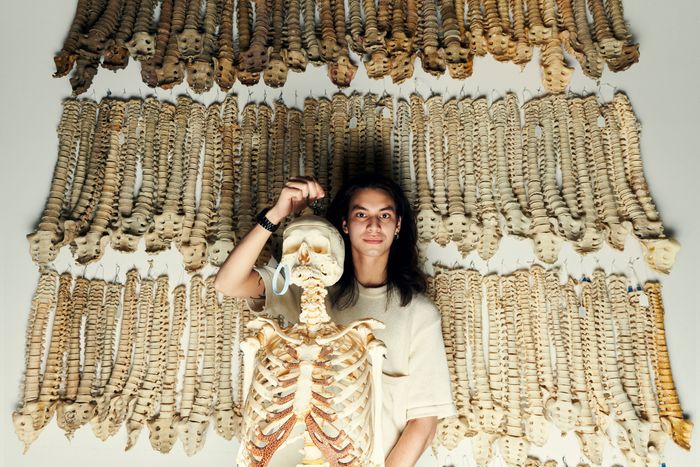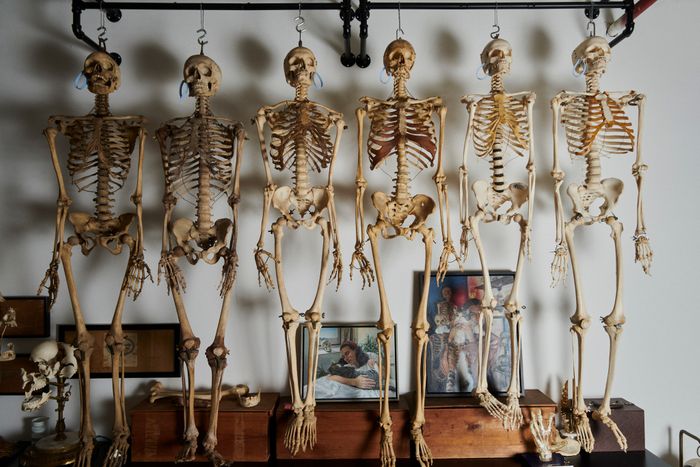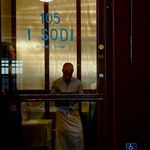
The small bright showroom is tucked inside a graffiti-covered Bushwick warehouse. The furniture is mid-century modern. A bergamot-and-lavender candle is burning. “Our motivation was, How could we do things differently? ” the young CEO in a blue chore coat says. The space is your typical direct-to-consumer start-up headquarters complete with earnest disrupter, except the products being disrupted aren’t sheets, mattresses, glasses, or bed frames. They are human bones: a tooth for $14, a vertebra for $50, a 19th-century skeleton for $6,600. On one wall hangs a massive collection of spines arranged in an ombré pattern; on the other, a Jo Malone diffuser sits atop a display case of skulls.
Jon “Jon Jon” Pichaya Ferry, a lanky 23-year-old, is shaking up the bones business. His company, JonsBones, sells “responsibly sourced human osteology,” a.k.a. human bones, and he wants to destigmatize a creepy industry, he says. He’s kind of a nü-goth bones-lifestyle influencer, greeting me at the appointment-only showroom one warm afternoon in May wearing a sterling-silver spinal-cord earring and a skull ring, which are available for purchase in the “Wearables” section of his sleek, Warby Parker–esque website.
Pointing out items from his collection, Ferry shows me the yellowed mouse skeleton in a small plastic box, a gift from his father, that ignited his passion at 13. “There’s nothing more well designed than the skeletal system,” he gushes. Born in Thailand (his mother, an architecture professor, is Thai) and raised partly in Indiana, Ferry dabbled in gymnastics and musical theater but was all in on bones by the time he moved to New York in 2018 to study product design at Parsons. He started articulating animal skeletons (i.e., cleaning and attaching bones in correct anatomical place) for private collectors and museums in his dorm room, using the money he made to print business cards and hand them out in Times Square. Then he saw his first human skull at Obscura Antiques & Oddities on Avenue A. “I was like, ‘Is this legal?’” he recalls. “And they were like, ‘Yeah, it’s no problem.’”
From there, Ferry became obsessed with the once-booming worldwide osteology business in which the buying and selling of human remains “was just as simple as purchasing a skull from a catalogue,” he says, flipping through one from his archives. There were 13 major medical-supply companies, mostly in the U.S., in the 19th and 20th centuries, Ferry explains, that articulated human skeletons and sold them to schools, doctors’ offices, and the odd secret society like the Freemasons. Demand was so great that donations could not meet it; companies sourced from those who had no choice, like executed prisoners and unclaimed corpses. Eventually, India became the human-remains capital of the world; after a ban there on the bones trade in 1985, the industry collapsed. Some companies pivoted to making plastic models.
But the artifacts of the bone boom are still out there, Ferry insists — hundreds of thousands of them. One report from the 1980s estimated that 60,000 skeletons and skulls were shipped to the U.S. from India in a single year. “People say, ‘Get rid of them.’ Okay, where?” he asks. It’s illegal in the U.S. to destroy human remains, at least without consent from next of kin. Donate them? Without proper documentation, he says, most museums won’t touch bones. Give them back? To whom? Because medical-grade skeletons are bleached, it’s very difficult to trace their DNA.
Ferry presents JonsBones as the solution, a way for people to conveniently unload these antiques — like Kaiyo but for bones instead of furniture. Committed to ethical sourcing, he claims he buys only medical-grade pieces; no tribal remains or any dated after the 1985 ban. He hires osteologists, pathologists, and forensic anthropologists as consultants who help identify the age and sex of the bones. Most sellers are individuals with family heirlooms. “A person will say, ‘My father was a physician. He just passed away. He had this medical skull on his desk. I don’t know what to do with it,’” Ferry says. He claims he has to turn down at least 60 percent of the offers he gets because there are simply too many in his inbox. There are hot spots for bones — one is New Jersey because medical-supply giant Clay Adams was based there. “New Jersey is huge,” Ferry intones.
Then the bones are tagged with a label, in JonsBones’s signature light blue, and added to the website for sale. Universities are his largest client, then search-and-rescue teams, which buy loose bones, and chiropractors. He excitedly shows me a video of a search-and-rescue dog digging up a JonsBones tibia. He says he tries to vet buyers for academic credentials but that JonsBones cannot ultimately be responsible for how consumers use the bones (that $6,600 skeleton “would be the perfect addition to any medical institution or respectful home,” the website reads). Bones are a seasonal business, but the busy season is not Halloween: In December, academics buy to stock their labs for the next year, Ferry says, and JonsBones tends to do about five big sales that month, mostly online, enough to make a small profit and pay his rent. “Right now, we are in the slow season,” he explains. The collection, which he housed in his Williamsburg apartment until opening the showroom last year, is valued at around $600,000.
Ferry knows what you must be thinking: A 23-year-old who sells human remains? “People say, ‘Oh, you must be obsessed with death. Are you Ted Bundy? Are you Jeffrey Dahmer?’” he says. New friends who aren’t grossed out treat his profession like a sideshow. “All I get is bone stuff” for the holidays, he laments. “A crystal-skull decanter, Crystal Head vodka.” Fortunately, his girlfriend wasn’t turned off when he told her on their first date, “I work with bones” (only one picture on his Bumble profile included a skeleton).
He has, however, been accused of being exploitative: In 2021, his JonsBones TikTok account, where he has nearly 500,000 followers, went viral after TikTokers criticized a skull on the website labeled LAPLANDER, an offensive term for the Sámi people, a northern-European ethnic group. (Ferry claims the skull was misidentified.) Someone doxed one of his handful of contractors, and trolls tried to get him kicked out of Parsons, from which he has just graduated. “It was brutal,” he says.
I am not a squeamish person, but one item in the JonsBones showroom did make me feel queasy: a fetal skeleton, fully assembled under a glass dome and nicknamed “Gordan” in the 1975 catalogue that listed it. As what Ferry calls a “sensitive piece,” it is not for sale, though he would donate it to a museum. “This doesn’t make you sad?” I ask him. “No,” Ferry replies matter-of-factly. Bones are not macabre to him, even tiny ones, but rather “the pinnacle of thoughtful design,” he explains. “I was born and raised Buddhist, so we see the body as more of a vessel.” He doesn’t find it odd to have a fetal skeleton sitting under two oil portraits of himself and his cat or across from his framed New York Post profile.
The latest addition to the JonsBones showroom is the result of Ferry’s college thesis: a wooden coatrack consisting of pale rings attached to a central spine and made to look like a human rib cage. “As a designer, I always say it’s gotta look like bones,” he tells me while demonstrating the prototype. Since graduating, he’s been thinking about how to realize his dream: an osteology version of the Noguchi Museum with his collection on display; it would be supported by a beautiful, hip store selling objects inspired by bones. More bones jewelry, bones furniture, bones sculpture, bones merch. He imagines customers using his rib-cage coatrack as a conversation piece: “‘Did you know it was originally inspired by a skeletal system?’ ‘Oh, I hadn’t even thought about that’ … Maybe it could be the next Eames chair.”
More From This Series
- Hopalong Andrew Is the Hardest-Working Cowboy Musician in Brooklyn
- Paul Schrader’s Very Paul Schrader Days in Assisted Living
- Riding Around Tompkins Square Park With the Citi Bike Boyz




